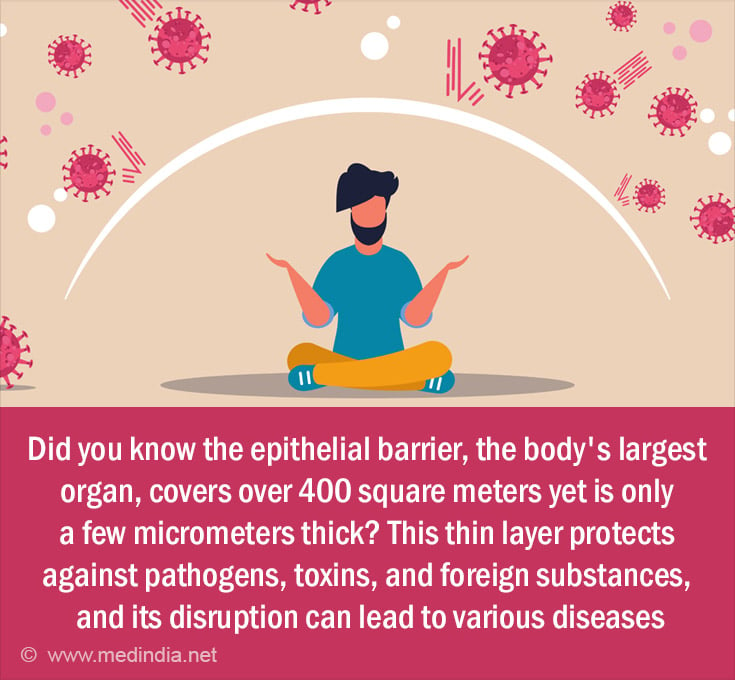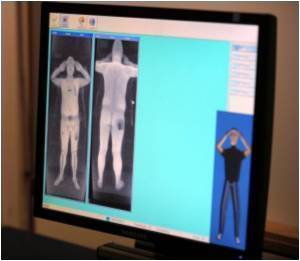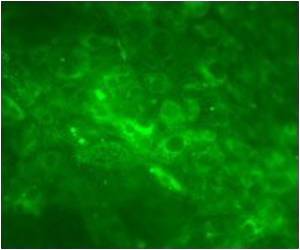- The epithelial barrier theory and its associated diseases - (https://onlinelibrary.wiley.com/doi/10.1111/all.16318#)
- The ocular surface epithelial barrier and other mechanisms of mucosal protection: from allergy to infectious diseases - (https://pmc.ncbi.nlm.nih.gov/articles/PMC3858173/#)
About
Over the past years, the epithelial barrier theory has emerged as a leading promontory to shifting focus towards chronic non communicable diseases(1✔ ✔Trusted Source
The epithelial barrier theory and its associated diseases
Go to source).
What is the Epithelial Barrier?
The epithelial barrier is made by the epithelial cells that are closely arranged and cover outer and inner surfaces of organs. As a barrier it separates the internal environment of the organism and acts as a shelter from pathogens, toxins and allergens. The epithelial barrier is for instance made of epithelial cells, tight junction and the basement membrane.
The epithelial barrier's primary functions include:
Selective Permeability: Functions to either passively allow or actively control the transportation of ions and molecules.
Protection: Provides protection against pathogen and toxic agents from coming into contact with body tissues.
Immune Response: Activates immune responses mechanisms to foreign bodies.
Did You Know?
The integrity of your epithelial barrier can significantly influence your overall health and susceptibility to chronic diseases! #medindia #epithelialbarrier
Epithelial Barrier Theory
According to the epithelial barrier theory, the compromised epithelial barrier makes one more prone to different diseases. This dysfunction is thought to be influenced by:
Environmental Exposures: The global production of more than new chemical substances has been introduced after the 1960s.
Microbial Dysbiosis: Disruption of the microbiota and Loss of induced and supportive bacterial flora and, therefore, the overgrowth of pathogenic bacteria.
Immune System Activation: Barriers dysfunctions leading to constant activation of immunity.
Inflammation: Chronic inflammation which resulted from immune mediated reactions.

Epithelial Barrier theory Associated Diseases
Skin Diseases
The fact that skin has a microbiome is very important for the functioning of the epithelial barrier and if it fails, there are likely to be many skin diseases.
Atopic Dermatitis: Related to changes in the epithelial barrier function and thus skin dryness and increased pruritus, and allergen penetration ability.
Alopecia Areata: Related with the barrier impaired cohesiveness and resulting in immune-mediated alopecia.
Allergic Contact Dermatitis: Results from sensitization by allergens which cross a compromised barrier and cause inflammation.
Irritant Contact Dermatitis: Consequences of exposure to environmental insults in the presence of a damaged skin surface.
Chronic Spontaneous Urticaria: associated with a barrier dysfunction leading to the uncontrolled activation of immune mediators, resulting in recurrent hives.
Psoriasis: Because of its connection with compromised barrier integrity leading to inflammations and formation of scales.
Bullous Pemphigoid: Related to immune responses and the skin because of barrier impaired functions.
Hidradenitis Suppurativa: Related to alteration of gut epithelial barrier and disruption of the microbial communities contributing to sustained inflammation.
Airway Diseases
Airway epithelial barrier encompasses the primary defense against inhaled substances and is impaired in various diseases.
Asthma: Linked to airway inflammation and barrier breakdown and thus affects breathing.
Allergic Rhinitis: Associated with nasal passages inflammation caused by allergens that compromise the barrier functions.
Chronic Rhinosinusitis: Chronic inflammation resulted in failure of epithelial barrier integrity in the sinuses.
Chronic Obstructive Pulmonary Disease (COPD): Linked to impaired barrier function responsible for lung disease.
Idiopathic Pulmonary Fibrosis: Related to epithelial barrier disruption, which results in fibrosis of lung parenchyma.
Digestive Tract Diseases
Intestinal barrier function serves to prevent the passage of pathogenic substances through the GI tract and is associated with several diseases.
Eosinophilic Esophagitis: An allergic condition which has been associated with impaired barrier function of the epithelial cells lining the esophagus.
Gastroesophageal Reflux Disease (GERD): Gastroesophageal reflux disease which weakens the barrier integrity of the esophagus.
Barrett's Esophagus: That may be associated with chronic GERD and barrier dysfunction is a precancerous one.
Food Allergy: A direct association has been made with immune reactions resulting from damaged GIT integrity.
Inflammatory Bowel Disease (IBD): Such include
Celiac Disease: An immunological intolerance to gluten that relates to barrier damage problems.
Irritable Bowel Syndrome (IBS): A dysphoric functional disorder which may have correlation with epithelial barrier disruption.
Colonic Diverticulosis: Structures forming pouches in the colon linked to barrier function problems.
Neuropsychiatric Diseases
Damage to the epithelial barrier, especially the one in the gastrointestinal tract, is associated with numerous neuro-psychiatric diseases.
Autism Spectrum Disorders: Associated with impaired gut barrier function in connection with neurodevelopment.
Parkinson's Disease: Known to be linked with gut health and integrity of the first line of defense to managing brain health.
Alzheimer's Disease: Associated with impaired gut barrier leading to neurodegeneration and memory loss.
Stress-Related Psychiatric Disorders: Irritant factors being associated with leaky gut and stress.
Chronic Depression: Associated with gut function and epithelial barrier dysfunction implicated in mood regulation.
Multiple Sclerosis: An autoimmune disease linked with the impaired integrity of the gut lining affecting nervous system integrity.
Autoimmune, Autoinflammatory, and Metabolic Diseases
This indicates that when the integrity of the intestinal epithelial barrier is destroyed there is potential for developing autoimmune diseases as a result of abnormal immune response due to microbial dysbiosis together with the increased permeability.
Autoimmune Thyroid Disease: Associated with epithelial barrier disruption due to increased permeability and impaired gut microbiota leading to the ability to provoke an immune response to thyroid autoantigens.
Systemic Lupus Erythematosus (SLE): Alteration of these microbiota and damaged gut barrier integrity promotes systemic inflammation and autoantibodies formation.
Ankylosing Spondylitis: Linked with the impaired microbiota and the permeability of the gastrointestinal tract as well as involved in inflammation in the spine.
Granulomatosis with Polyangiitis: Abnormal flora and impaired gut mucosa contribute to systemic and vascular inflammation severity.
Autoimmune Hepatitis: Dysbiosis of gut microbiota and the breakdown of the intestinal barrier may lead to the activation of autoimmunity with the liver tissue target.
Behçet's Syndrome: Maybe due to change in the gut microbiota and epithelial barrier breakdown leading to formation of recurrent ulcers and skin lesions.
Rheumatoid Arthritis: Worsened by enhanced intestinal permeability as well as microbial imbalance resulting in pro-inflammatory conditions within joints.
Osteoarthritis: Besides traditional degenerative joint disease mechanisms, the pathogenesis of the condition may include gut inflammation resulting from epithelial barrier dysfunction.
Ocular Diseases
The ocular surface barrier is the first line of defense of an eye against pathogens and allergens and dysfunction to result in various diseases(2✔ ✔Trusted Source
The ocular surface epithelial barrier and other mechanisms of mucosal protection: from allergy to infectious diseases
Go to source).
Ocular Allergy: Linked to the breakdown of the epithelial layer and permit antigens to invade the ocular tissues and cause allergy.
Age-Related Macular Degeneration (AMD): Associated with inflammation and the change of function of the retinal pigment layer and can be modulated by the reaction of systemic inflammation due to the dysfunction of the barrier.
Dry Eye Disease: Known to disrupt the epithelial barrier leading to the worsening of tear film stability and inflammation of the ocular surface.
Glaucoma: It has been evidenced that some recent works attempted to uncover the relationship between glaucoma and the increased level of inflammation and barrier dysfunction.
Uveitis: Uveitis which may be induced by systemic autoimmune diseases and can be assisted by altered barriers.
Other Diseases
Other diseases have also been linked to epithelial barrier dysfunction, the diseases include:
End-Stage Renal Disease (ESRD): Associated with changes in systemic inflammation and increases in intestinal permeability; an aggravating factor in metabolism disorders.
Osteoporosis: Chronic inflammation and impaired gut-bone axis are considered to develop as a result of epithelial barrier disruption.
Severe COVID-19: Inflammation and impaired epithelial barrier may be the causes and predictors of the severity of COVID-19, especially in people with preexisting diseases associated with barrier dysfunction.
Long COVID: Persistent clinical manifestations after acute SARS-CoV-2 infection possibly related to a long-lasting epithelial barrier damage.
Polycystic Ovary Syndrome (PCOS): Linked to metabolism and inflammation possibly affected by epithelial barrier breakdown.
Cardiovascular Diseases: Including hypertension and structural heart disease, where barrier dysfunction may worsen the inflammatory state and vascular integrity.









